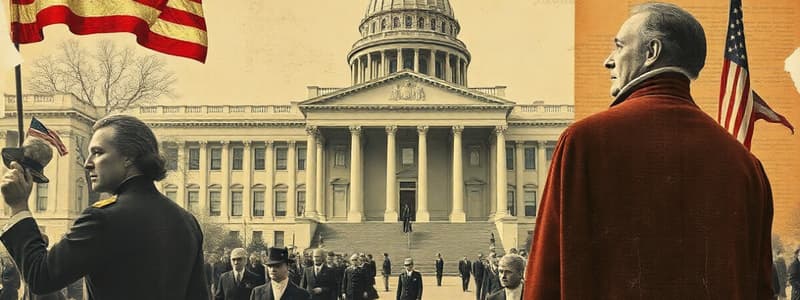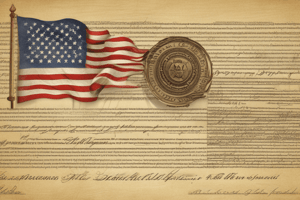Podcast
Questions and Answers
What did southern delegates argue regarding the counting of enslaved people for representation?
What did southern delegates argue regarding the counting of enslaved people for representation?
- Enslaved people should be counted the same as any other people. (correct)
- Enslaved people should be fully represented as citizens.
- Enslaved people should not be counted at all.
- Enslaved people should be counted as property.
Most northern delegates viewed enslaved people as full citizens entitled to representation.
Most northern delegates viewed enslaved people as full citizens entitled to representation.
False (B)
Who became president of an antislavery society in 1787?
Who became president of an antislavery society in 1787?
Benjamin Franklin
Enslaved people were often compared to __________ in terms of being considered property.
Enslaved people were often compared to __________ in terms of being considered property.
Match the following delegates with their viewpoints on slavery:
Match the following delegates with their viewpoints on slavery:
How did the economy of the Southern states relate to slavery?
How did the economy of the Southern states relate to slavery?
Some southern states began to pass laws making it easier to free enslaved people.
Some southern states began to pass laws making it easier to free enslaved people.
What fundamental question did Gouverneur Morris raise about representation?
What fundamental question did Gouverneur Morris raise about representation?
The division among white Americans regarding slavery was accelerated by the __________ and the American Revolution.
The division among white Americans regarding slavery was accelerated by the __________ and the American Revolution.
What sentiment was growing among some white Americans towards slavery during this time?
What sentiment was growing among some white Americans towards slavery during this time?
What was the outcome of the debate over the New Jersey Plan?
What was the outcome of the debate over the New Jersey Plan?
James Wilson believed representation in Congress should be based on the population of states.
James Wilson believed representation in Congress should be based on the population of states.
Who proposed the compromise that would later be known as the Great Compromise?
Who proposed the compromise that would later be known as the Great Compromise?
The small states feared that the large states would seek to __________ them in Congress.
The small states feared that the large states would seek to __________ them in Congress.
Match the following delegates with their views:
Match the following delegates with their views:
What did Gunning Bedford warn might happen if the large states continued to dominate?
What did Gunning Bedford warn might happen if the large states continued to dominate?
The first house of Congress established by the Great Compromise is called the House of __________.
The first house of Congress established by the Great Compromise is called the House of __________.
The Senate would have representatives based on the population of each state.
The Senate would have representatives based on the population of each state.
What was the vital concern expressed about the United States falling apart?
What was the vital concern expressed about the United States falling apart?
What significant issue arose after the agreement on the Great Compromise?
What significant issue arose after the agreement on the Great Compromise?
Flashcards
Apportionment
Apportionment
The process of determining how many representatives each state gets in the House of Representatives, based on population.
The Representation Debate
The Representation Debate
The debate over whether enslaved people should be counted as citizens for purposes of representation in the House of Representatives.
Southern Argument
Southern Argument
The argument presented by Southern delegates during the Constitutional Convention that enslaved people should be counted as full citizens for purposes of representation.
Northern Argument
Northern Argument
Signup and view all the flashcards
Enslaved People as Property
Enslaved People as Property
Signup and view all the flashcards
Antislavery Movement
Antislavery Movement
Signup and view all the flashcards
New Thinking on Slavery
New Thinking on Slavery
Signup and view all the flashcards
South's Economic Dependence on Slavery
South's Economic Dependence on Slavery
Signup and view all the flashcards
Easing of Slavery Restrictions in the South
Easing of Slavery Restrictions in the South
Signup and view all the flashcards
Benjamin Franklin's Antislavery Role
Benjamin Franklin's Antislavery Role
Signup and view all the flashcards
What was the Great Compromise?
What was the Great Compromise?
Signup and view all the flashcards
What was the New Jersey Plan?
What was the New Jersey Plan?
Signup and view all the flashcards
What did proponents of the Virginia Plan want?
What did proponents of the Virginia Plan want?
Signup and view all the flashcards
What was the main conflict over representation in Congress?
What was the main conflict over representation in Congress?
Signup and view all the flashcards
How did the Great Compromise solve the debate?
How did the Great Compromise solve the debate?
Signup and view all the flashcards
What issue arose after the Great Compromise?
What issue arose after the Great Compromise?
Signup and view all the flashcards
What was the Three-Fifths Compromise?
What was the Three-Fifths Compromise?
Signup and view all the flashcards
What was the Southern states' argument on slave representation?
What was the Southern states' argument on slave representation?
Signup and view all the flashcards
What was the Northern states' argument on slave representation?
What was the Northern states' argument on slave representation?
Signup and view all the flashcards
What was the lasting impact of the Three-Fifths Compromise?
What was the lasting impact of the Three-Fifths Compromise?
Signup and view all the flashcards
Study Notes
The Great Compromise: Resolution of Representation
- The New Jersey Plan, favored by small states, was rejected by most delegates as insufficient.
- Delegates from large states favored representation based on population.
- James Wilson argued that representation should reflect the people, not states.
- Small states feared dominance by large states.
- Gunning Bedford warned of potential foreign intervention if small states were not protected.
- Rufus King expressed concern about the possibility of the US failing.
- Roger Sherman proposed a compromise plan.
Details of the Great Compromise
- The compromise created a bicameral (two-house) Congress.
- The House of Representatives would be based on state population, representing the people.
- The Senate would represent the states, with each state having two senators.
The Enslaved Population Issue
- The Great Compromise raised the issue of how to count enslaved people for representation purposes.
- Southerners wanted enslaved people counted for representation to increase their political power.
- Northern delegates argued that enslaved people should not be counted as citizens but rather as property.
- The debate highlighted differing views on enslaved people as people versus property.
- Elbridge Gerry argued that enslaved people were property.
- Gouverneur Morris suggested making enslaved people citizens if counted for representation.
Shifting Views on Slavery
- The American Revolution and the Declaration of Independence challenged existing views on slavery.
- Some white Americans began to oppose slavery.
- Benjamin Franklin became president of an antislavery society.
- Northern states started abolishing slavery.
- Southern states were less ready to abolish slavery due to economic dependence on enslaved labor.
- Some southern states eased the process of freeing enslaved people.
Studying That Suits You
Use AI to generate personalized quizzes and flashcards to suit your learning preferences.



